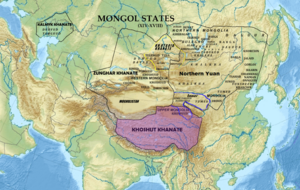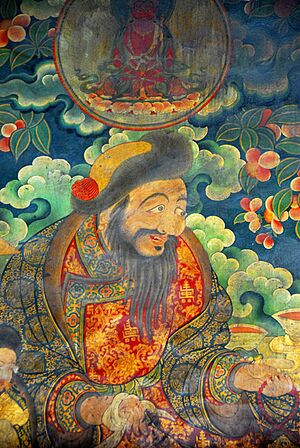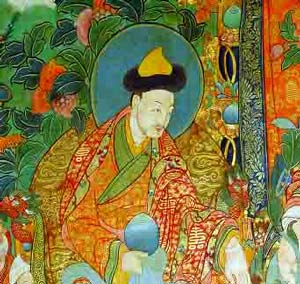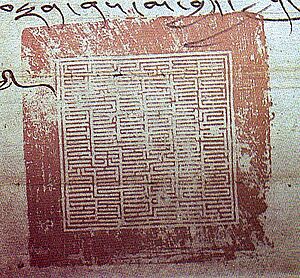Khoshut Khanate facts for kids
Quick facts for kids
Khoshut Khanate
ᠬᠣᠱᠤᠳ ᠤᠯᠤᠰ
和碩特汗國 |
|||||||||
|---|---|---|---|---|---|---|---|---|---|
| 1642–1717 | |||||||||

Location of the Khoshut Khanate among Mongol tribes
|
|||||||||
| Status | Nomadic empire | ||||||||
| Religion | Tibetan Buddhism | ||||||||
| Government | Monarchy | ||||||||
| History | |||||||||
|
• Established
|
1642 | ||||||||
|
• Disestablished
|
1717 | ||||||||
|
|||||||||
| Today part of | China | ||||||||
The Khoshut Khanate was a powerful Mongol kingdom that existed in the Tibetan Plateau from 1642 to 1717. It was founded by a leader named Güshi Khan. He helped the Gelug school of Tibetan Buddhism become the main religious group in Tibet.
Güshi Khan worked with the 5th Dalai Lama to set up a government called Ganden Phodrang. The Khoshut Khanate's role in Tibet is sometimes debated. Some say the Khoshut leaders did not get involved in Tibet's daily matters. They believe the relationship was like a "priest and patron," where the khan protected the Dalai Lama. Others suggest that Güshi Khan appointed a minister to handle civil affairs, leaving the Dalai Lama to focus on religious duties.
In 1654, Güshi Khan accepted the rule of the Qing dynasty in China. The Khoshut Khanate ended in 1717. This happened when the Dzungar army invaded Tibet. They killed the last Khoshut ruler, Lha-bzang Khan, and put the 7th Dalai Lama in power.
Contents
History of the Khoshut Khanate
Who were the Oirats?
The Oirats were a group of Mongol people. They originally lived near Tuva in the early 1200s. Their leader, Quduqa Bäki, joined forces with Genghis Khan in 1208. Over time, the Oirats moved west. This was because other Mongol groups, like the Khalkha, became more powerful.
In the early 1600s, the Oirats faced many conflicts. They fought against other Mongol groups. These battles often involved their leaders and families.
Güshi Khan's Rule (1642-1655)
In 1625, a family dispute led to a fight among the Oirat Khoshut leaders. Toro-Baikhu, who later became Güshi Khan, became famous for his fighting skills. He was known as one of "Akhai's herd of tigers." After winning these conflicts, Toro-Baikhu took the title "Dai Güshi" Taiji.
In 1632, the Gelug school of Buddhism in Qinghai was facing problems. A rival group, the Khalkha, was attacking them. The 5th Dalai Lama asked Güshi Khan for help in 1634. The Oirats already supported the Gelug tradition. Güshi Khan gathered an army to help.
In 1636, Güshi Khan led 10,000 Oirats into Qinghai. They defeated a much larger enemy army. He then went into Central Tibet. There, the 5th Dalai Lama gave him the title of Bstan-'dzin Choskyi Rgyal-po. This means "the Dharma King Who Upholds the Religion." Güshi Khan became the first Mongol leader not from Genghis Khan's family to be called a "khan."
Güshi Khan encouraged many Oirats to move to Kokono. This helped create the Khoshut Khanate. He conquered different parts of Tibet. By 1642, Güshi Khan had brought all of Tibet under the control of the Gelug school. The 5th Dalai Lama then declared Güshi Khan the khan of Tibet.
To keep control, Güshi Khan set up a government. The Dalai Lama focused on religious matters. A minister, Sonam Rapten, handled civil affairs. Güshi Khan wanted the Gelug tradition to be the main religion of his kingdom. This helped make his rule stronger.
When Güshi Khan died in 1655, his son Tenzin Dorje, known as Dayan Khan, became the next khan of Tibet.
Ochirtu's Influence
Ochirtu Khan was Güshi Khan's nephew. He helped Sengge, Güshi's grandson, become the leader in 1661. Later, Sengge was killed. Ochirtu then helped Sengge's younger brother, Galdan Boshugtu Khan, defeat the killers. Galdan married Ochirtu's granddaughter, Anu-Dara. However, Ochirtu and Galdan later had a conflict. Ochirtu was defeated in 1677.
Lha-bzang Khan's Reign (1703-1717)
There are different stories about how Lha-bzang Khan became ruler. One story says he became khan in 1703 because his older brother was sick. Lha-bzang Khan had only visited Lhasa once before becoming ruler.
Lha-bzang Khan had problems with the Tibetan regent, Desi Sangye Gyatso. The regent tried to control the 6th Dalai Lama. The Dalai Lama and Lha-bzang Khan had a good relationship at first. However, the regent tried to harm Lha-bzang Khan.
In 1705-1706, Lha-bzang Khan entered Lhasa. He had the regent killed and removed the 6th Dalai Lama from power. Lha-bzang Khan wanted the support of the Kangxi Emperor of the Qing dynasty. The Emperor asked for the 6th Dalai Lama to be sent to Beijing. But the Dalai Lama died on the way in 1706.
Lha-bzang Khan then presented a new monk as the true Dalai Lama. This monk was installed in 1707. However, many Gelug followers did not accept him. The Khoshut chiefs in Kokonor were also unhappy. In eastern Tibet, local lamas found another child they believed was the true reincarnation of the 6th Dalai Lama. Lha-bzang Khan tried to stop this, but he failed. The Kangxi Emperor did not officially recognize either boy right away.
During his rule, Lha-bzang Khan tried to make life easier for the people of Tibet. He stopped some unfair trading practices. But he struggled to gain the full support of the Gelug Buddhist leaders.
In 1717, the Dzungar army invaded the Khoshut Khanate. They killed Lha-bzang Khan and took control of Lhasa. The Dzungars did not bring the boy from Lithang to Lhasa. They also caused problems for the people, losing the support of the Gelugpa. The Qing dynasty sent a large army in 1720. They drove the Dzungars out of Tibet. They brought the boy from Kumbum to Lhasa. He was then installed as the 7th Dalai Lama in 1721.
Khoshut Khanate's Role in Tibet
The Ganden Phodrang was the government of Tibet led by the Gelug school. It was set up in 1642. The Khoshut Khanate was very important in its creation. They defeated the enemies of the Gelug school. The Mongols also helped with Tibet's military defense.
Historians have different ideas about the khan's role in the government. Some say the khan did not get involved much in Tibet's daily running. They believe the relationship was mainly about the khan protecting the Dalai Lama. Other historians say that Güshi Khan gave the 5th Dalai Lama power over Tibet. But the Dalai Lama needed help with the actual administration. So, an office called desi was created to manage the country.
Some sources also say that after the deaths of Sonam Rapten and Güshi Khan in the 1650s, the 5th Dalai Lama gained more control over his government. The important role of Güshi Khan in the rise of the Ganden Phodrang was celebrated for many years. Even in the 20th century, people wore Mongol military clothes during festivals to honor Güshi Khan's troops.
Khoshut Khans
- Güshi Khan: 1642–1655
- Dayan Khan: 1655–1668 (Güshi Khan's son)
- Tenzin Dalai Khan: 1668–1696 (Dayan Khan's son)
- Tenzin Wangchuk Khan: 1696–1697 (Tenzin Dalai Khan's son)
- Lha-bzang Khan: 1697–1717 (Tenzin Wangchuk Khan's brother)
See also
- Mongol conquest of Tibet
- Qing conquest of Tibet
- List of rulers of Tibet
- Tibet–Ladakh–Mughal War




